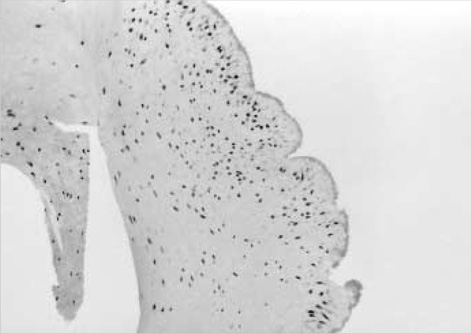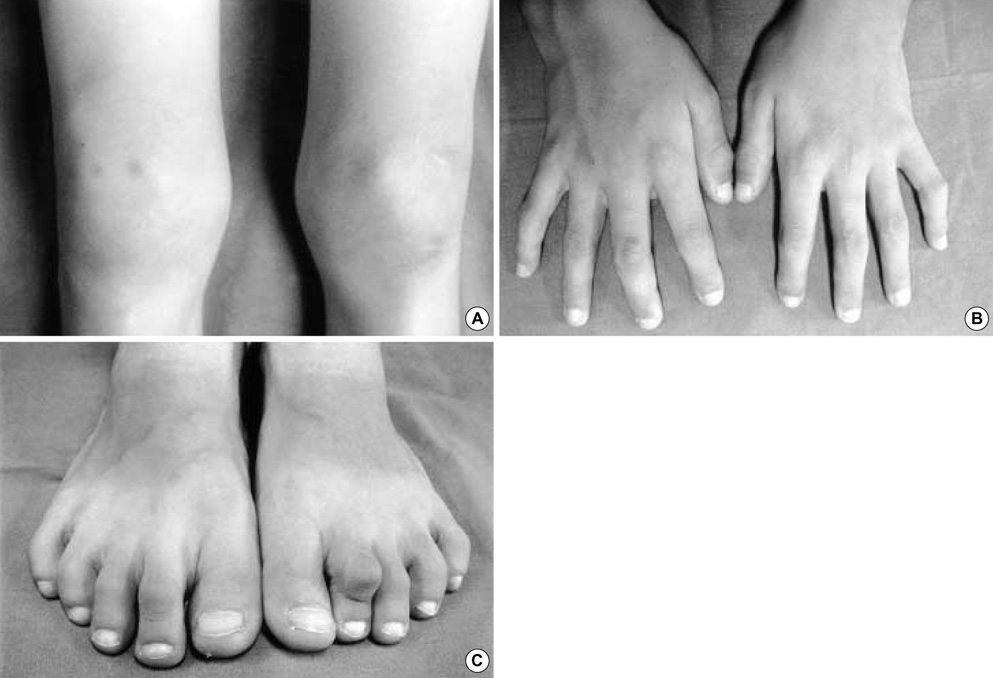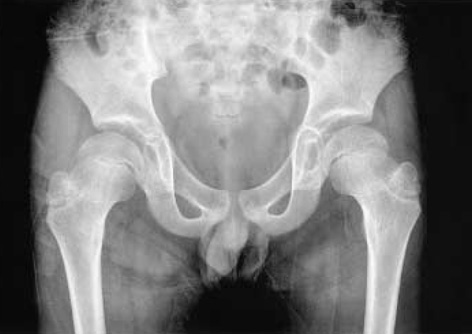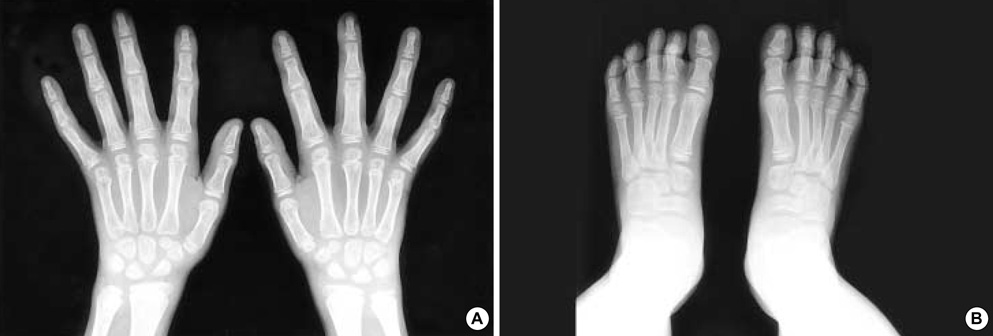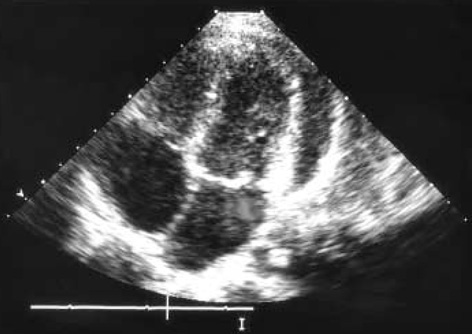J Korean Med Sci.
2004 Dec;19(6):907-910. 10.3346/jkms.2004.19.6.907.
Camptodactyly, Arthropathy, Coxa vara, Pericarditis (CACP) Syndrome: A Case Report
- Affiliations
-
- 1The Hospital of Rheumatic Diseases, Department of Internal Medicine, Hanyang University, Seoul, Korea. dhyoo@hanyang.ac.kr
- 2Department of Diagnostic Radiology, Hanyang University, Seoul, Korea.
- 3Department of Pathology, Hanyang University, Seoul, Korea.
- 4Department of Pediatrics, Hanyang University, Seoul, Korea.
- 5Hanyang Rheumatism Clinic, Jeonju, Korea.
- KMID: 1778580
- DOI: http://doi.org/10.3346/jkms.2004.19.6.907
Abstract
- The camptodactyly-arthropathy-coxa vara-pericarditis syndrome (CACP) is characterized by congenital or early-onset camptodactyly, childhood-onset noninflammatory arthropathy associated with synovial hyperplasia. Some patients have pro-gressive coxa vara deformity and/or noninflammatory pericardial effusion. CACP is inherited as an autosomal recessive mode and the disease gene is assigned to a 1.9-cM interval on human chromosome 1q25-31. We describe a 10-yr-old boy who has typical features of CACP without familial association.
MeSH Terms
Figure
Reference
-
1. Bahabri SA, Suwairi WM, Laxer RM, Polinkovsky A, Dalaan AA, Warman ML. The camptodactyly-arthropathy-coxa vara-pericarditis syndrome: clinical features and genetic mapping to human chromosome 1. Arthritis Rheum. 1998. 41:730–735.
Article2. Martinez-Lavin M, Buendia A, Delgado E, Reyes P, Amigo MC, Sabanes J, Zghaib A, Attie F, Salinas L. A familial syndrome of pericarditis, arthritis, and camptodactyly. N Engl J Med. 1983. 309:224–225.
Article3. Engber WD, Flatt AE. Camptodactyly: an analysis of sixty-six patients and twenty-four operations. J Hand Surg. 1977. 2:216–224.
Article4. Oh SH, Kim EY, Park YB, Park SK, Yang JR. A case of Catel Manzke syndrome. J Korean Pediatr Soc. 1999. 42:1154–1158.5. Han MG, Kim KY, Son DW, Moon HR. Pena-Shokeir I Syndrome in a newborn infant. J Korean Pediatr Soc. 1997. 40:721–725.6. Ochi T, Iwase R, Okabe N, Fink CW, Ono K. The pathology of the involved tendons in patients with familial arthropathy and congenital camptodactyly. Arthritis Rheum. 1983. 26:896–900.
Article7. Martin JR, Huang SN, Lacson A, Payne RH, Bridger S, Fraser FC, Neary AJ, MacLaughlin EA, Hobeika C, Lawton LJ. Congenital contractural deformities of the fingers and arthropathy. Ann Rheum Dis. 1985. 44:826–830.
Article8. Hugosson C, Bahabri S, McDonald P, al-Dalaan A, al-Mazyed A. Radiological features in congenital camptodactyly, familial arthropathy and coxa vara syndrome. Pediatr Radiol. 1994. 24:523–526.
Article9. El-Garf A, Mahmoud G, Gheith R, Abd El-Aaty G, Abd El-Aaty H. Camptodactyly, arthropathy, coxa vara, and pericarditis syndrome among Egyptians. J Rheumatol. 2003. 30:1081–1086.10. Herve-Somma CM, Sebag GH, Prieur AM, Bonnerot V, Lallemand DP. Juvenile rheumatoid arthritis of the knee: MR evaluation with Gd-DOTA. Radiology. 1992. 182:93–98.
Article11. Cohen PA, Job-Deslandre CH, Lalande G, Adamsbaum C. Overview of the radiology of juvenile idiopathic arthritis (JIA). Eur J Radiol. 2000. 33:94–101.
Article12. Faivre L, Prieur AM, Le Merrer M, Hayem F, Penet C, Woo P, Hofer M, Dagoneau N, Sermet I, Munnich A, Cormier-Daire V. Clinical variability and genetic homogeneity of the camptodactyly-arthropathy-coxa vara-pericarditis syndrome. Am J Med Genet. 2000. 95:233–236.
Article13. Bulutlar G, Yazici H, Ozdogan H, Schreuder I. A familial syndrome of pericarditis, arthritis, camptodactyly, and coxa vara. Arthritis Rheum. 1986. 29:436–438.
Article14. Laxer RM, Cameron BJ, Chaisson D, Smith CR, Stein LD. The camptodactyly-arthropathy-pericarditis syndrome: case report and literature review. Arthritis Rheum. 1986. 29:439–444.
Article15. Verma UN, Misra R, Radhakrisnan S, Maitra SC, Agarwal SS, Singh RR. A syndrome of fibrosing pleuritis, pericarditis, and synovitis with infantile contractures of fingers and toes in 2 sisters: "familial fibrosing serositis". J Rheumatol. 1995. 22:2349–2355.16. Marcelino J, Carpten JD, Suwairi WM, Gutierrez OM, Schwartz S, Robbins C, Sood R, Makalowska I, Baxevanis A, Johnstone B, Laxer RM, Zemel L, Kim CA, Herd JK, Ihle J, Williams C, Johnson M, Raman V, Alonso LG, Brunoni D, Gerstein A, Papadopoulos N, Bahabri SA, Trent JM, Warman ML. CACP, encoding a secreted proteoglycan, is mutated in camptodactyly-arthropathy-coxa varapericarditis syndrome. Nat Genet. 1999. 23:319–322.
Article

